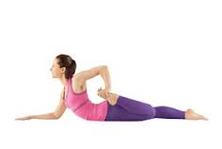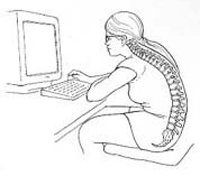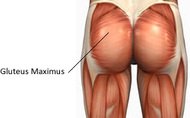 The following stretching routine is really effective for those suffering from an achy, stiff lower back, doing this routine regularly will really help to stretch out all the muscles that may be tight, tense and contributing to low back pain. 1. Ardha apanasana (knee-chest pose). Start lying down on the floor, wearing loose, comfortable clothing and remove shoes and socks. Start with both feet flat on the floor and hug the right knee in towards the chest, this helps to stretch the gluteal muscles, if you have limited flexibility stay with the left knee bent, if you have more range of motion lengthen the left leg long actively pressing the thighbone down towards the ground. Keep the head and shoulders relaxed down to the ground and stay for 20-30 seconds before switching to the other side.  2. Supta padangusthasana (hamstring stretch). Grab a yoga strap if you have one, if not you can use a tie or a dressing gown strap or anything else that resembles a strap and place it around the big and little toe mound, straightening the leg to create a stretch in the hamstring, if you have very tight hamstrings start with the bottom leg bent and the foot flat on the floor, for those with more flexibility lengthen the bottom leg along the floor and actively press the thigh towards the ground. Relax the shoulders here and stay for as long as 5-10 breaths or between 30-60 seconds per side.  3. Supta matsyendrasana (supine twist). Draw your right knee in towards your chest and release the knee over to the left, take your right arm out to the side and rest your left hand on your right knee to create an anchor, if the knee doesn't come all the way down to the ground you may place a pillow or blankets underneath so that it doesn't feel like it is hanging in mid-air. Release your right shoulder down to the ground and if its comfortable on your neck gaze over your right shoulder, stay for 5-10 breaths before switching to the other side.  4. Sucirandrasana (eye of the needle pose). Place both feet back on the floor and place your right ankle onto the top of the left thigh, if you begin to feel a stretch here then stay just gently guiding your right thigh away from your face with your right hand, if you want more of a stretch thread the hands or a strap around the left thigh guiding the left knee in towards the chest as you use your right elbow to guide the right elbow away from your head. You should feel sensation into the outer right hip, lengthening the lateral rotators of the hip particularly the piriformis muscle which can get tight and impinge on the sciatic nerve causing piriformis syndrome. Stay here for 5-10 breaths, just breathing into the strong sensations in the hip area, then repeat on the opposite side.  5. Anjayanasana (hip flexor stretch). If you spend a lot of time sitting chances are your hip flexors are going to be tight. Starting off from hands and knees bring your right foot in between your hands, take your back knee back enough so you can begin to feel a sense of opening on the front of the left thigh, place your hands either on your front thigh or on your hips and allow the pelvis to release down as you lengthen your tailbone down and begin to peel your belly away from your front thigh. Keep your hands on the front thigh or on your hips or sweep your arms up over head lengthening the sides of the waist. Stay for 5 breaths before repeating on the other side.  6. Ardha bhekasana (half frog pose). Come to lay on your belly, place your right forearm horizontally in front of your belly bending your left leg and taking hold of your left foot with your left hand, moving the heel towards the left hip making sure the knee is in line with the hip, drawing your belly in towards the spine as you lengthen your tailbone down towards your heels and lengthen up through your heart. Stay for up to 5 breaths before repeating on the right side.  7. Ardha adho mukha svanasana (half downward facing dog at the wall). Come to a wall space and place feet hip distance apart, place palms of the hands shoulder distance apart against the wall spreading through the fingers. Bend the knees first of all to create the curvature in the spine, if you find when straightening your legs that your lower back rounds then stay with the knees bent moving the tops of the thighbones back to create length through the spine. If you can keep the lumbar curve with straight legs then moving the legs towards straight and stay for 5-10 breaths creating length through the full length of the back body.  8. Parsva tadasana (sidebending mountain pose). Stand with feet hip distance apart, inhale arms up overhead, interlace fingers and press palms up towards the sky, lengthen the sides of your waist as you root down from the pelvis and legs into the ground, exhale over to the right rooting down even more into the left leg stay for 3-5 breaths returning back to centre and exhaling to the left. You can repeat 2-3 times really feeling the skin, muscles and connective tissue beginning to lengthen on the side body. This is a wonderful stretch for the quadratus lumbormum and latisimus dorsi muscles on the side body which often get neglected. This whole sequence should take 8-10 minutes to complete and works to release the muscles that assist to support and stabilise the low back. Enjoy! And I would love to hear how you get on with this little sequence, please comment in the comment section below.
2 Comments
"If your spine is inflexibly stiff at 30, you are old. If it is completely flexible at 60, you are young." Joseph Pilates  We all know someone with back pain or have probably experienced it ourselves at some point, statistics suggest that 4 out of 5 people will suffer with it at some point in our lives. Often the causes of low back pain are mysterious, you can have all the tests and MRI's that are available and still be none the wiser as to the cause. More often than not the cause of low back pain is damage to the soft tissue, which isn't picked up by x-rays and MRI's. The muscles, ligaments and fascia can be adversely affected by habitual poor posture, injury or trauma and chronic misuse and under-use of the soft tissues in the area. Studies suggest that trigger points (contraction "knots" in soft tissue) are a component of up to 93% of the pain seen in pain clinics and the sole cause of such pain as much as 85% of the time. (Gershwin; Fishbain quoted in Travell and Simons: Myofascial Pain and Dysfunction: The Trigger Point Manual Volume 1.) Trigger points are knots in the muscle which most often refer pain to a site distant to where the trigger point is located, so trigger points found in the Erector Spinae group, Quadratus Lumborum, Piriformis, Psoas and Gluteals can all contribute to pain in the lower back.  Posture plays a huge role in the health of our spine and all the structures surrounding it, there is a common belief that when we go to the gym or go for a run we are training our body which we are, but more importantly every single moment of every day we are training our body in the way we sit, the way we walk and this is even more important than the hour or two we spend each week or even each day we spend doing "training". Sitting in chairs is one of the worst things we can do for our postures it often encourages a posterior tilt of the pelvis, over stretching the musculature of the back and shortening the hip flexors on the front not to mention collapsing the diaphragm and making less space for the organs. If sitting in chairs can not be completely avoided then there are several things you can do to encourage a healthier posture, sit with your behind behind you and not in front of you, sitting on your ischial tuberosities (the two bony points in your buttocks) encourages the natural curvature in the spine avoiding the c-shaped "slump and dump" spine and helping to maintain the natural s-shaped curvature of the spine. Get up and move regularly, the spinal discs are spongy and cushion the vertabrae, but they naturally have poor blood supply, movement allows fluid to circulate around the discs.  Sorry ladies you're not going to like this (and maybe some gents too if you're into that sort of thing), what we wear on our feet is of huge importance not only to the health of our feet but also to the rest of our body. High heels completely throw the alignment of the body out, in order to maintain balance the calf muscles, hips and back have to tense so that we literally don't fall forward causing the muscles to fatigue and cramp. So if you want relief from low back pain ditch the heels, heels compress and damage the lumbar spine increasing osteoarthritis and degenerative disc disease in the low back.  Take a moment to think about how many movements you take your spine through every day.... Did you come up with many? Our spine is able to flex and extend (think forward bend and backward bend), laterally flex (side bend), and each of the vertabra in the spine are also able to rotate (twist). Ideally you should be taking the spine through its full range of motion everyday, if you don't use it you lose it.  One of the main culprits of low back pain is weak butt muscles, gluteal muscles not only stabilise the tailbone they help support the function of the low back muscles. If the glutes are weak, the lower back muscles have to work harder than normal to stabilise which makes them fatigued and sore. Squats are a great way to tone the gluteal muscles. So if you have low back pain or discomfort, have a think about how you are using your body every day, bring some healthy movement patterns in to your body and book in with a skilled body worker who can release some of those troublesome trigger points that are causing pain and can show you some self care stretches you can do at home!
|
AuthorAdvanced clinical massage therapist and yoga teacher. Archives
December 2023
Categories
All
|
 RSS Feed
RSS Feed